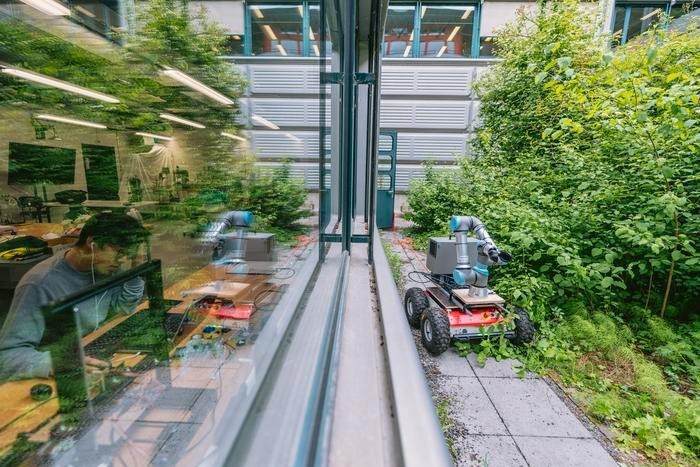
The tomato picker robot designed with ChatGPT by researchers from TU Delft and EPFL moves through a testing environment. Image Credit: © Adrien Buttier / EPFL
Such new AI developments have given a source of inspiration to scientists at the Delft University of Technology (TU Delft) and the Swiss technical university EPFL to gain a little more insight.
The scientists reported their outcomes in the Nature Machine Intelligence journal.
What are the greatest future hardships faced by humanity? This was the first question that Cosimo Della Santina, assistant professor, and Ph.D. student Francesco Stella, both from TU Delft and Josie Hughes from EPFL, asked ChatGPT.
We wanted ChatGPT to design not just a robot, but one that is actually useful.
Della Santina, Assistant Professor, Delft University of Technology
Finally, they selected food supply as their difficulty, and as they chatted with ChatGPT, they developed the concept of making a tomato-harvesting robot.
Helpful Suggestions
According to Stella, the scientists followed all of ChatGPT’s design decisions. The input proved especially useful in the conceptual phase.
ChatGPT extends the designer’s knowledge to other areas of expertise. For example, the chat robot taught us which crop would be most economically valuable to automate. Make the gripper out of silicone or rubber to avoid crushing tomatoes’ and ‘a Dynamixel motor is the best way to drive the robot.
Della Santina, Assistant Professor, Delft University of Technology
At the time of the implementation phase, ChatGPT came up with beneficial suggestions.
The study outcomes of this collaboration between humans and AI are a robotic arm that could harvest tomatoes.
ChatGPT as a Researcher
The scientists discovered that the collaborative design process is positive and enriching.
However, we did find that our role as engineers shifted towards performing more technical tasks.
Della Santina, Assistant Professor, Delft University of Technology
In the journal Nature Machine Intelligence, the scientists explore the altering degrees of a partnership between humans and Large Language Models (LLM), among which ChatGPT is one.
Risk of Misinformation
“In fact, LLM output can be misleading if it is not verified or validated. AI bots are designed to generate the ‘most probable’ answer to a question, so there is a risk of misinformation and bias in the robotic field,” states Della Santina.
Also, working with LLMs lifts other significant problems, like traceability, plagiarism, and intellectual property.
Della Santina, Stella, and Hughes will continue to utilize the tomato-harvesting robot in their research. Also, they are continuing their study of LLMs to design new robots. Particularly, they are studying the autonomy of AIs in developing their bodies.
Stella concluded, “Ultimately an open question for the future of our field is how LLMs can be used to assist robot developers without limiting the creativity and innovation needed for robotics to rise to the challenges of the 21st century.”
Journal Reference
Stella, F., et al. (2023) How can LLMs transform the robotic design process? Nature Machine Intelligence. doi.org/10.1038/s42256-023-00669-7